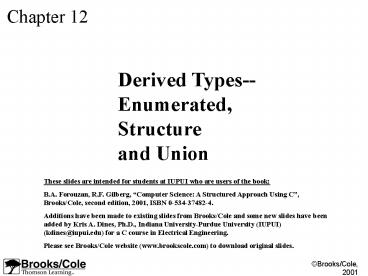Derived Types - PowerPoint PPT Presentation
1 / 25
Title:
Derived Types
Description:
Please see Brooks/Cole website (www.brookscole.com) to download original s. ... struct fraction // a 'tagged' structure { // can reuse for many variables ... – PowerPoint PPT presentation
Number of Views:23
Avg rating:3.0/5.0
Title: Derived Types
1
Chapter 12
Derived Types-- Enumerated, Structure and Union
These slides are intended for students at IUPUI
who are users of the book B.A. Forouzan, R.F.
Gilberg, Computer Science A Structured Approach
Using C, Brooks/Cole, second edition, 2001, ISBN
0-534-37482-4. Additions have been made to
existing slides from Brooks/Cole and some new
slides have been added by Kris A. Dines, Ph.D.,
Indiana University-Purdue University (IUPUI)
(kdines_at_iupui.edu) for a C course in Electrical
Engineering. Please see Brooks/Cole website
(www.brookscole.com) to download original slides.
2
Derived Types
- Those made from existing types.
- Arrays are collections of existing types
- int array11,2,3
- Pointers are address locations of existing types
- float x
- float pxx
- Can also define our own groups of variables and
give that group a name. (structs)
3
Figure 12-1 Derived types available in C
4
Figure 12-2 Type definition using typedef
typedef int Int32 // Integer of specific
size (32-bit machine) Int32 ivalue
// New type used as any other Int32
pValueivalue
Identifier (better)
5
More typedef Examples
- String type
- typedef char String
- Use it String myString156
- Pointer type
- typedef int pInt
- int a
- pInt pa
6
Figure 12-3 Enumerated type discrete set of
values with names
for only one variable
tag creates a type to use for defining many
variables
7
Figure 12-4 Enumerated type set of constants
Symbolic names rather than integers red0,
white1,,, yellow4 (constants)
With tag enum color color0red
With typedef COLORS color0red
Use anywhere integers are used
8
Reassigning Constant Integer Values of enum
Symbols
- Set to unique, but arbitrary integers
- enum TV fox11, abc5, cnn66
- Start at one and increment by one
- enum months Jan1,Feb, Mar, Apr,,, etc.
9
Enumerated Type Example
- enum TV fox11, abc5, cnn66 // define it
- int main()
- enum TV myChannelcnn // TV variable is
myChannel - if(myChannelfox)
// Test for fox - printf(I am watching the world series\n)
- else
- printf(I am not watching the world series\n)
10
12-3 Structures
- structure collection of related data elements
- various types
- represents some mathematical or problem domain
object. - field a data element in the structure
11
Structures Representing Fractions
- struct fraction // a tagged structure
- // can reuse for many variables
- int numerator
- int denominator
- struct fraction frac1 // declare a fraction
variable - struct // structure variable declaration
- // just defines frac1 variable...cannot
reuse - int numerator
- int denominator
- frac1 // just defines frac1... would have
to - //
repeat for frac2, etc. ? useless
12
Structures Representing Fractions (Contd.)
- struct fraction // a tagged structure
- // can reuse for many variables
- int numerator // (put in a header file)
- int denominator
- int main()
- struct fraction frac1 // Accessing fields
- frac1.numerator3 // 3/4
- frac1.denominator4
- //...
13
typedefd Structure
- Recall
- typedef int Int32
- typedef struct fraction
- int numerator
- int denominator
- Fraction // new type
14
Typedef Structures Representing Fractions
(Contd.)
- typedef struct fraction // a typedefd structure
- // can reuse for many variables
- int numerator // (put in a header file)
- int denominator
- Fraction
- int main()
- Fraction frac1 // Accessing fields
- frac1.numerator3 // 3/4
- frac1.denominator4
- //...
15
Typedef Structures Representing Fractions
(Contd.) Use these
- typedef struct fraction // a typedefd structure
- // can reuse for many variables
- int numerator // (put in a header file)
- int denominator
- Fraction // traditional format
- typedef struct int numerator int
denominator Fraction // equivalent - OR
- typedef struct / can leave off tag if
typedefd/ - int numerator
- int denominator
- Fraction
Existing type
New type
16
Figure 12-5
FILE fp // Pointer to a FILE structure
17
Figure 12-10 struct format variations
18
Figure 12-11 Initializing structures
19
12-4 ACCESSING FIELDS IN STRUCTURES
- Each field is just a variable usable as such
- Fraction frac13,4 // the fraction ¾
- frac1.numerator3 // same as above...
- frac1.denominator4
dot is the member operator that digs into a
structure to get a variable then use it like any
other variable
20
Multiply Fractions
- typedef struct
- int numerator
- int denominator FRACTION
- int main (void)
- /Local Definitions /
- FRACTION fr1
- FRACTION fr2
- FRACTION res
- / Statements read two fractions /
- printf("Write the first fraction in the form of
x/y ") - scanf ("d /d", fr1.numerator,
-
fr1.denominator) - // contd........
- // main() contd.........
- printf("Write second fraction in the form of
x/y ") - scanf ("d /d", fr2.numerator,
-
fr2.denominator) - // the actual multiply
- res.numerator fr1.numerator
fr2.numerator - res.denominator fr1.denominator
fr2.denominator - printf("\nThe result of d/d d/d is d/d",
- fr1.numerator, fr1.denominator,
- fr2.numerator, fr2.denominator,
- res.numerator, res.denominator)
- return 0
21
Operations on Structures
- Assignment or copy is the only one except for
those you program yourself. - Fraction frac13,4 // 3/4
- Fraction frac21,2 // 1/2
- frac2frac1 // now frac2 holds 3/4
// element-by-element copy
22
Figure 12-13
23
Figure 12-14 Pointers to structures
ptr.x is WRONG dot takes precedence (ptr)
goes to where the structure lives
24
Pointer Selection Operator( p-gtmember )
- Fraction frac13,4 //a Fraction initialized
- Fraction pFrac1 // pointer to a Fraction
- pFrac1frac1 // pointer has value
addressof(frac1) - // Equivalent ways to access member fields
- frac1.numerator17 // dot member operator
- (pFrac1).numerator17 // deref pointer then dot
into it - pFrac1-gtnumerator17 // selection
operator (preferred) - // e.g., mul numerators
- pFrac3-gtnumerator (pFrac1-gtnumerator)
(pFrac2-gtnumerator)
25
LECTURE 9 END































